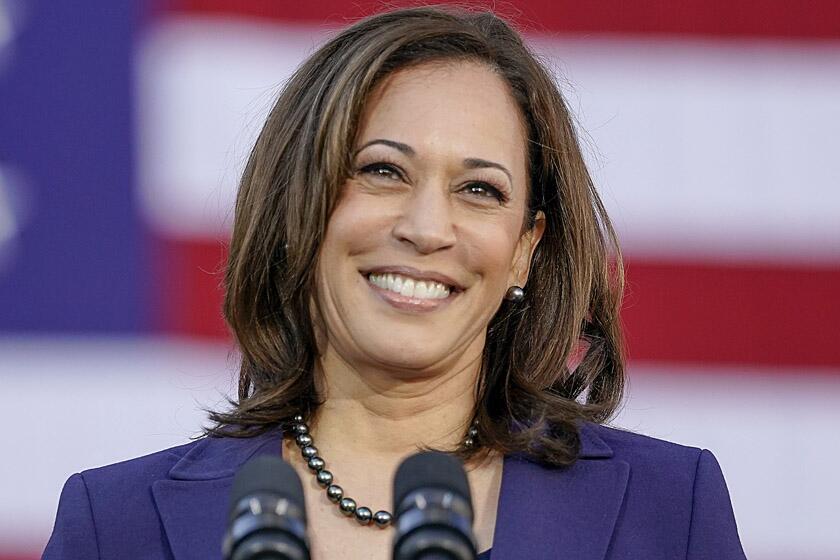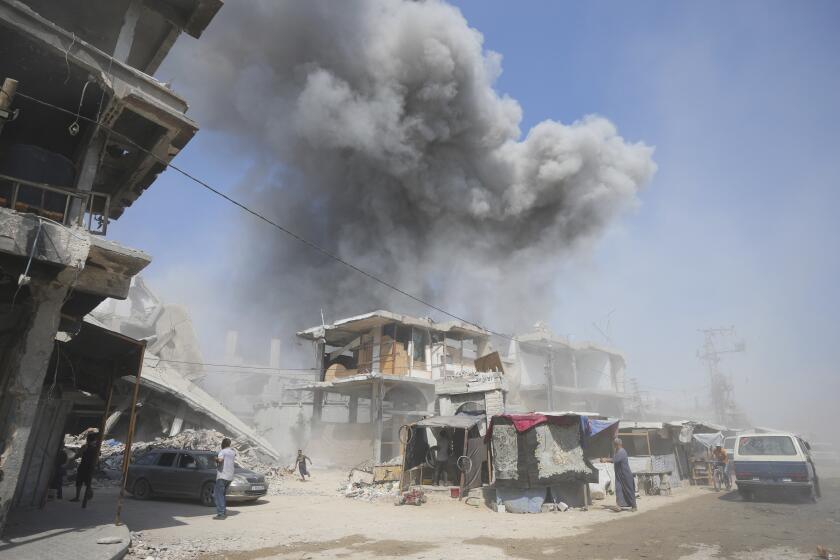Emergency Rooms in U.S. Listed in Critical Condition
The looming breakdown of hospital emergency services in Los Angeles is simply the most acute symptom of a fast-spreading disease afflicting emergency health care systems nationwide, health officials say.
Doctors around the United States describe emergency rooms as explosive pressure cookers where intense human suffering collides on a daily basis with harsh new economic realities confronting hospital officials.
More and more people are arriving sicker and poorer at busy inner-city emergency rooms. Hospitals, however, are increasingly unwilling to absorb the cost of caring for them, due to tight budgets caused by stringent government cost controls, low occupancy rates, and, in some cases, debts from overexpansion.
Looking to cut their losses, hospitals have closed their trauma centers or curtailed basic emergency service. In many instances, the pressure behind the move is coming from doctors who are refusing to treat the patients.
Four private hospitals in downtown Los Angeles plan to close their emergency rooms next month to public ambulances that transport victims of 911 distress calls; five other hospitals have threatened to follow suit.
Los Angeles is “probably at the epicenter of this critical problem,” said Dr. Stephen Groth, president of the California chapter of the American College of Emergency Physicians. But all over the country, he said, hospital emergency rooms “are on the front line” of conflict in the health care industry.
Dr. Howard Champion, chief of trauma at Washington Hospital Center in Washington, said that hospitals, especially in poor urban areas, are considering curtailment of emergency services.
In Houston, the president of the 900-bed Herman Hospital, Jeptha Dalston, said, “I think we’ll soon be where you (in Los Angeles) are at right now.”
South Florida has already been dealt a devastating blow. Seven of the eight trauma centers in Miami have closed. And the Florida Hospital Assn. has reported that 35% of the state’s 220 emergency deparments have reduced service for lack of physicians.
In New York City, the problem is one of serious overcrowding. Hospitals are so full of critically ill patients that they back up into the emergency room, creating “medical gridlock,” according to Dr. Lewis Goldfrank at the city-operated Bellevue Hospital Center.
Pressure on emergency rooms throughout the city, he said, is so great that he has publicly advocated calling in the National Guard to help with the caseload.
“The whole system is starting to come unglued at the seams and fall apart,” said Dr. Larry Bedard, of Sausalito, former president of the California chapter of the American College of Emergency Physicians.
“It’s like a big pot boiling over,” said Robert Heilig, an official with the California Assn. of Hospitals and Health Systems. “We felt the heat first in trauma care, and now it’s happening in emergency services.”
Small Communities Also
Seven of the 23 trauma centers in Los Angeles have closed during the last three years. Others are threatening to drop out in San Diego and San Jose, as well as small communities like Castro Valley. In Marin County, a large hospital is considering opening a trauma center--but only upon passage of a pending ballot initiative that would guarantee financial support.
Trauma centers are, in a sense, the crown jewel of an emergency services network. Usually located within or next to a hospital emergency room, these units are specially staffed to treat victims of violent accidents, shootings and stabbings who typically need immediate and specialized medical care.
But the trauma patient pool makes up only a small fraction of the entire emergency patient load.
Many more people--heart attack victims, women in labor, patients in respiratory arrest or suffering from seizures, comas, overdoses and lacerations, as well as minor illnesses--typically seek treatment in hospital emergency rooms.
Better Medical Care
Generally, the medical care there has improved enormously over the last decade, due to technological advances and better training of emergency physicians.
“Fifteen years ago, emergency rooms were sleepy little places,” Groth said. “The doctor on duty might just be a moonlighting dermatologist. . . . They (emergency room doctors) were considered to be misfits who weren’t good enough or smart enough to open up a practice. But that has changed 180 degrees.”
Equipped to handle not only the sickest patients arriving by ambulance, the emergency room has been increasingly flooded by so-called “walk-in traffic”--patients with minor illnesses and injuries who regard the emergency room as their primary source of medical care. Their ranks have been swelled by record numbers of people--20% of the population in California under age 65--who lack health insurance or other means of paying private doctors.
Often for financial reasons, patients have postponed treatment, making many of them sicker than ever when they finally arrive at the emergency room.
‘Guaranteed Access Point’
“The emergency room has become the only guaranteed access point to the health care system in America,” said Dr. Michael Krentz, a Dallas physician who is president of the American College of Emergency Physicians. Most private physicians, he pointed out, “expect payment up front,” and have “the right to refuse to take somebody as a patient for whatever reason.” However, in the emergency room, all patients must be treated and stabilized without regard to their financial status.
At the same time, no comprehensive system has been established in California or in many other states to help hospitals and doctors defray the expense of treating patients who can not pay their bills.
“The result of this schizophrenic thought process is that health care providers, both hospitals and physicians, are left holding the bag,” Groth said. “Society has dictated what will be provided, but is unwilling to underwrite its own wishes.”
Different Viewpoint
But some health care advocates are not so sympathetic to the plight of the hospitals.
They point out that private hospitals in California shoulder a lower percentage of the cost of uncompensated care than their counterparts in other states. Furthermore, they say that many private hospitals have received enormous tax breaks, low-interest loans and federal grants for construction projects with the expectation that they will fulfill their charitable obligations to serve the public--rich and poor alike.
Attorneys for the National Health Law Project have vowed to seek a temporary restraining order preventing the California Medical Center and three smaller downtown Los Angeles hospitals from drastically curtailing their emergency room service on Aug. 1.
They point out that the medical center--part of a $1-billion, 14-hospital nonprofit health care conglomerate called UniHealth America--has received millions of dollars in federal grants and tax-exempt bond money to expand and modernize its 327-bed hospital at 1414 S. Hope St.
“This hospital has benefited from millions of dollars in government funding,” said attorney Standley Dorn. “It is not like a private oil business that is free to turn the tap on and off whenever it suits the bottom line. They’ve received public funds, so they owe an obligation to serve the public.”
Change in Status
The surest way for a hospital to avoid some of the sickest and poorest patients is to “down-license” the emergency room to standby status, thereby shutting off rescue ambulances that transport patients in 911 distress cases.
If California, The Hospital of the Good Samaritan, French Hospital and Linda Vista Community Hospital down-license their emergency rooms, as planned, they will shut off rescue ambulances carrying a total of about 1,400 patients a month--an estimated one-third of whom have no health insurance or other means of paying their bills.
Five other major private hospitals have threatened to follow suit in a devastating chain reaction of cutbacks that would shift a massive increase in patients into the already swamped public hospitals.
At risk would be hundreds of people who happen to become sick or injured while living, working or traveling through Central Los Angeles.
“There’s going to be the practical equivalent of a war zone,” said Dr. Marshall Morgan, director of emergency medicine at UCLA Medical Center. “What will eventually get people’s attention is that a lot of high-powered executives work in these tall buildings downtown, and when one of them has a coronary, the paramedics won’t get there in time. When they do, it will take longer to get to a hospital. And when he gets there, he’ll be the fifth in line for the only (heart) defibrillator.”
The only requests now on file with the state for emergency room down-licensing have come from downtown Los Angeles hospitals, state health officials said.
But Heilig of the hospital association said he knows of hospitals that are just waiting to see what happens in Los Angeles. One administrator, he said, has been given blanket permission from his board of directors to downgrade the emergency room at any time.
After a recent fact-finding trip to San Diego, the staff director for the state Senate subcommittee that oversees health care legislation, James Lott, said: “San Diego is not too far from where Los Angeles is right now. We probably will see some emergency rooms either downgrade to standby status or close altogether so they can control the flow of indigent and unpaying patients into the hospitals.”
Special concern is focused on the threatened closure of Physicians and Surgeons Hospital, a private hospital in southeast San Diego owned by National Medical Enterprises.
The closure of this hospital, which has shouldered an enormous indigent load, would put pressure on other hospital emergency rooms. Officials at nearby Paradise Valley Hospital are already considering such defensive options as closing the emergency room to paramedic traffic, said Dr. Richard Stennes, president of a group of 35 emergency physicians who now staff three hospitals in San Diego.
He said his group quit staffing Physicians Hospital because “in a good month, our reimbursement was 21% of charges and we couldn’t get backup (physicians).”
Throughout the state and nation, hospitals are having serious problems motivating staff specialists--orthopedists, obstetricians, surgeons and the like--to participate on hospital “call panels” that serve as a backup medical staff for emergency rooms or trauma centers, doctors and hospital officials acknowledged.
The specialists complain that too many patients cannot pay their bills, that reimbursement through the government insurance programs is too low and time-consuming, and that medical malpractice insurance rates are too high. In California, many doctors have been scared off by a new state law that imposes criminal penalties on doctors, who when serving on call panels, withhold treatment from unpaying or undesirable patients.
Angry Doctors
One San Diego hospital, Stennes said, was so short of physicians volunteering to serve on the call panels that participation was made mandatory--whereupon all but one of the obstetricians resigned.
Bedard pointed to two hospitals in San Bernardino County where all the orthopedists have refused to serve on call panels and to a hospital in Gilroy, south of San Jose, where “the medical staff revolted” when doctors were required to serve.
Collaboration Needed
Most health officials agree that a solution to the problem of uncompensated care will require the broad-scale collaboration of both private and public officials. “The ultimate resolution of this problem will require action by elected officials at all levels of government and the private sector,” said state health services director Dr. Kenneth Kizer. Several states have moved in major ways to address the problem.
In New Jersey, the state has set up an Uncompensated Care Trust Fund designed to redistribute and equalize the burden on hospitals throughout the state. The way it works is that the state establishes a uniform, statewide flat rate that is added onto hospital bills and charged to all health care payers in the state. Hospitals with uncompensated care costs that are lower than the add-on level remit the difference to the fund. Those hospitals with costs higher than the add-on receive the difference.
“Nine states have hospital pools where they distribute money among hospitals and then collect it, and put it in a pool and then divvy it out to those hospitals providing disproportionate care to the poor,” said Los Angeles health care consultant Geri Dallek.
But Krentz said that the pending cutbacks in private emergency room services in Los Angeles are an ominous sign for the whole nation. “Southern California seems to be the harbinger of things to come,” he said. “Unless there’s something done to relieve the situation, hospitals are going to close our shops. The necessary consultants (call panel doctors) will not be there to help us, and we’ll reach the point where we won’t be able to do our job. I could envision major metropolitan areas without any sort of emergency medical capability, if current trends continue.”
More to Read
Sign up for Essential California
The most important California stories and recommendations in your inbox every morning.
You may occasionally receive promotional content from the Los Angeles Times.






